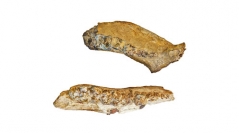

 Comptes Rendus Palevol
15 (3-4) - Pages 359-378
Comptes Rendus Palevol
15 (3-4) - Pages 359-378The Indo-French Program of Research ‘Siwaliks’ carried out investigations in the ‘Quranwala zone’ of the Masol Formation (Tatrot), Chandigarh Siwalik Range, known since the 1960s for its “transitional fauna”. This new paleontological study was implemented following the discovery of bones with cut marks near choppers and flakes in quartzite collected on the outcrops. Nine fieldwork seasons (2008–2015) on 50 hectares of ravines and a small plateau recovered lithic tools and fossil assemblages in 12 localities with approximately 1500 fossils. Their study shows that the most abundant mammal species are the Proboscideans with Stegodon insignis . The transition with the Pleistocene fauna is evidenced by Elephas hysudricus, Hipparion antelopinum and Equus sivalensis. The freshwater mammal is also well illustrated with Hexaprotodon sivalensis. Bovids present the greatest variety with six tribes from the smallest to the largest. Two types of cervids are observed; Sivatherium giganteum is visible in several localities and Merycopotamus dissimilis in one. Turtles, with the giant terrestrial Colossochelys and the freshwater Geoclemys , are abundant. The aquatic predators are limited (crocodile) and terrestrial carnivores are very scarce (hyena, felid). The faunal assemblages match the Plio-Pleistocene transitional fauna, also described in the Pabbi Hills (Pakistan), and mark the beginning of the Equus sivalensis Biostratigraphic interval-Zone, which extends from 2.6 Ma to 600 ka. The systematic repetition of surveys has, therefore, allowed the collection of rare taxa, such as Crocuta (2010), Merycopotamus dissimilis (2014) and a large felid (2015). These latest findings are significant for the discovery of Homininae in Siwaliks.
Siwalik Frontal Range, Sub-Himalayan floodplain, Late Pliocene, Tatrot faunal assemblage